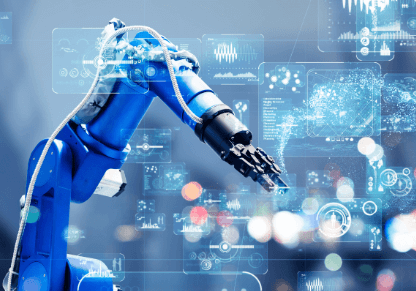Introduction
In the evolving landscape of industry, robots in manufacturing are no longer science fiction—they are central to the how, when, and where of modern production. These intelligent machines automate repetitive tasks, enhance precision, and help factories adapt quickly to changing demands. As manufacturers aim to stay competitive in Industry 4.0 and beyond, understanding robotics, automation, and their integration with data systems becomes vital.
This article explores the role of robots in manufacturing, their types, applications, benefits, challenges, and future trends. We’ll weave in LSI keywords such as “industrial robots,” “robotic automation,” “collaborative robots (cobots),” “end-of-arm tooling (EOAT),” “smart factory,” and “robotics integration.” You’ll also find a section of FAQs drawn from common queries people ask about robots in manufacturing. The writing emphasizes E-E-A-T (Experience, Expertise, Authoritativeness, Trustworthiness) by using up-to-date facts, research results, and balanced perspectives.
Let’s dive in and see how robotics is reshaping manufacturing from the shop floor up.
What Are Robots in Manufacturing?
“Robots in manufacturing” refers to automated robotic systems deployed inside factories to carry out tasks traditionally done by humans. These tasks include assembly, welding, painting, material handling, inspection, packaging, and more.
Industrial robots are programmable machines capable of multi-axis motion (three or more axes). They often carry end-of-arm tooling (EOAT)—special tools such as grippers, sensors, welding torches, or suction cups—that allow them to interact physically with parts and products.
Robotic systems may work independently, semi-autonomously, or in collaboration with human operators (in the case of cobots).
Types of Robots in Manufacturing
Different robot types are optimized for different tasks. Here are some of the key robot categories you should know:
- Articulated Robots
These are the “robot arm” designs many imagine: joints and segments allow movement like a human arm. Commonly 6-axis, they deliver high flexibility and reach. - SCARA Robots
Standing for Selective Compliance Assembly Robot Arm, SCARA robots are excellent for tasks in a horizontal plane, such as insertion, assembly, and pick-and-place. - Cartesian Robots (Gantry Robots)
These move along linear axes (X, Y, Z). They are well suited for packaging, loading/unloading, and pick-and-place operations. - Delta Robots
Delta robots are lightweight, fast, and precise, predominantly used for high-speed pick-and-place tasks. Their payload capacity is limited, which restricts their use for heavier tasks. - Cylindrical and Polar Robots
Less common, these robot types move along cylindrical or polar coordinates; they’re used in niche or spatially constrained tasks. - Collaborative Robots (Cobots)
Cobots are designed to share the workspace with humans. They incorporate safety features like force limiting and collision detection. They can be reprogrammed easily and used for flexible, lower-volume production. - Mobile Robots, AGVs and AMRs
Some robots move around the factory floor—automated guided vehicles (AGVs) or autonomous mobile robots (AMRs) transport parts, tools, or finished goods. These augment fixed robots by connecting processes.
Applications of Robots in Manufacturing
Robots are versatile. Here are the common roles they fulfill on the production floor:
- Welding & Joining
Robots execute spot welding, arc welding, laser welding consistently with minimal error. - Painting & Coating
Automatized painting ensures uniform coverage, reduced waste, and less exposure to harmful fumes. - Assembly & Insertion
Robots perform precise assembly steps, such as inserting screws, placing small parts, or fitting components. - Material Handling & Pick-and-Place
Robots move raw materials, parts, and products between stations or packaging. - Machine Tending
They load/unload parts into CNC machines, presses, or other equipment to maintain continuous operation. - Quality Inspection & Testing
Vision systems and sensors enable robotic inspection, detecting defects and ensuring consistency. - Packaging & Palletizing
Robots wrap, pack, and palletize products for shipping. - Logistics & Intra-factory Transport
Mobile robots (AGVs, AMRs) carry parts across different production zones.
Because robots generate data—from their sensors, vision systems, movement logs—they become integral to smart factories and data-driven manufacturing.
Benefits of Using Robots in Manufacturing
Implementing robots offers multiple strategic and operational advantages:
- Increased Productivity & Throughput
Robots can operate 24/7, reduce cycle times, and maintain consistent output levels. - Higher Precision & Quality
Their repeatability ensures tighter tolerances and fewer defects. - Enhanced Safety
Robots can take over dangerous tasks such as welding, handling toxic chemicals, or lifting heavy loads, reducing worker injuries. - Flexibility & Scalability
Especially with modular EOAT and reprogrammable robots, manufacturers can switch product lines with minimal downtime. - Cost Savings (Long-Term ROI)
Though initial investment is high, cost per unit tends to drop due to labor savings, lower error rates, and higher uptime. - Data & Analytics
Robotic systems generate real-time operational data—useful for predictive maintenance, process optimization, and supply chain alignment. - Consistency & Reliability
Robots don’t suffer fatigue, so they maintain performance over long durations.
Challenges & Considerations
No technology is without hurdles. Here are common challenges when integrating robots:
- High Capital & Integration Costs
The upfront cost of robots, sensors, controllers, and integrating with existing systems can be substantial. - Complex Programming & Maintenance
Specialized skills are needed to program, maintain, and troubleshoot robotic systems. - Change Management & Workforce Upskilling
Human workers need retraining to supervise, program, and collaborate with robots. - Interoperability & Legacy Systems
Integrating robotics with older equipment or software can be difficult and expensive. - Flexibility Limitations
Some robots are optimized for high-volume, fixed tasks; they struggle when product variants are many. - Safety & Regulations
Ensuring safe human-robot collaboration requires robust safety design and compliance with standards. - Return on Investment Uncertainty
The payback period can vary depending on task complexity, volume, and utilization.
Best Practices for Implementing Robots in Manufacturing
To maximize success:
- Start with Pilot Projects
Deploy robots in low-risk, high-return tasks to prove value before scaling. - Select Appropriate EOATs (End-of-Arm Tooling)
The right gripper or tool can dramatically affect robot effectiveness. - Blend Human & Robot Strengths (Human-Robot Collaboration)
Use cobots or augmented systems so humans handle decision-making, while robots carry out repetition. Recent research explores using large language models (LLMs) to facilitate human-robot communication. - Data Integration & Digital Twin
Connect robots to MES/ERP systems, build digital twins, and use analytics to optimize performance. - Continuous Maintenance & Monitoring
Use predictive maintenance and condition monitoring to minimize downtime. - Training & Change Management
Upskill staff in robot programming, supervision, and safety. - Scalability & Modularity
Design systems that can expand or adapt as production changes.
Emerging Trends & Future Directions
- Humanoid & Intelligent Robots
Humanoid robots (e.g. Tesla’s Optimus project) are being explored to perform varied tasks in unstructured environments. - Swarm Robotics & Distributed Automation
Collections of smaller robots working together (swarm manufacturing) enhance flexibility and resilience. - AI & Machine Learning Integration
Robots will increasingly adapt via AI—improving grasping, path planning, and decision-making. - Lightweight Materials & Novel EOAT Designs
Use of carbon fiber, soft robotics, and modular tooling will expand robot capabilities. - Industry 6.0 Vision
Research envisions future factories where generative AI designs production and robot swarms orchestrate it autonomously. - Edge & Cloud Robotics
Offloading computation to edge or cloud systems to coordinate multiple robots and systems.
FAQs (People Also Ask)
1. How do robots improve manufacturing efficiency?
Robots reduce cycle times, cut errors, maintain consistent output, and free humans to focus on higher-value tasks. They also supply operational data that can drive further optimizations.
2. What is the difference between industrial robots and cobots?
Industrial robots are often fenced off and perform isolated operations. Cobots are designed to safely share a workspace with humans, with built-in sensors and force limiters.
3. What kinds of end-of-arm tooling are used in robotic manufacturing?
EOATs include grippers (mechanical, vacuum, magnetic), welding torches, sensors, suction cups, and vision-based tools tailored to specific tasks.
4. What industries use robots most heavily?
The automotive industry is a major user of robots for welding, painting, and assembly. Electronics, aerospace, pharmaceuticals, food & beverage, and logistics also widely adopt robotics.
5. What is the ROI or payback time for deploying robots?
Payback depends on task type, volume, labor cost, and utilization. In high-throughput, repetitive tasks, ROI can often be achieved in 2 to 5 years. In lower-volume or variable environments, the return may take longer.
Conclusion
Robots in manufacturing have transformed the way goods are produced, merging mechanical precision with digital intelligence. From speeding up production cycles and enhancing product quality to safeguarding worker safety and enabling data-driven decision-making, their impact is vast. The shift toward robotic automation, smart factories, and collaborative robotics paves the way for future advances—such as AI-driven robots and swarm systems.
However, successful implementation requires thoughtful integration, the right tooling, employee training, and continuous optimization. When approached strategically, robotics can deliver significant returns, resilience, and competitive advantages in an increasingly automated industrial world.
As you explore robotics for manufacturing, consider small pilots, data integration, and human-robot collaboration. The future of production is not just machines—it’s machines plus intelligence, flexibility, and partnership.




